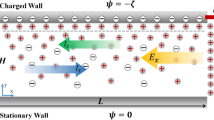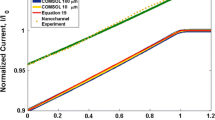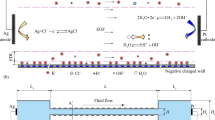Abstract
The microfluidic system is a multi-physics interaction field that has attracted great attention. The electric double layers and electroosmosis are important flow-electricity interaction phenomena. This paper presents a thickness-averaged model to solve three-dimensional complex electroosmotic flows in a wide-shallow microchannel/chamber combined (MCC) chip based on the Navier-Stokes equations for the flow field and the Poisson equation to the electric field. Behaviors of the electroosmotic flow, the electric field, and the pressure are analyzed. The quantitative effects of the wall charge density (or the zeta potential) and the applied electric field on the electroosmotic flow rate are investigated. The two-dimensional thickness-averaged flow model greatly simplifies the three-dimensional computation of the complex electroosmotic flows, and correctly reflects the electrookinetic effects of the wall charge on the flow. The numerical results indicate that the electroosmotic flow rate of the thickness-averaged model agrees well with that of the three-dimensional slip-boundary flow model. The flow streamlines and pressure distribution of these two models are in qualitative agreement.
Similar content being viewed by others
References
Kim, E., Xia, Y., and Whitesides, G. M. Polymer microstructures formed by moulding in capillaries. nature, 376, 581–584 (1995)
Woolley, A. T., Hadley, D., and Landre, P. Functional integration of PCR amplification and capillary electrophoresis in microfabricated DNA analysis device. Anal. Chem., 68, 4081–4086 (1996)
Clayton, J. Go with the microflow. Nature Methods, 2(8), 621–627 (2005)
Fu, L. M., Lin, J. Y., and Yang, R. J. Analysis of electroosmotic flow with step change in zeta potential. Journal of Colloid and Interface Science, 258(2), 266–275 (2003)
Ren, C. L. and Li, D. Q. Improved understanding of the effect of electrical double layer on pressure-driven flow in microchannels. Analytica Chimica Acta, 531, 15–23 (2005)
Chao, K., Chen, B., and Wu, J. K. Numerical analysis of field-modulated electroosmotic flows in microchannels with arbitrary numbers and configurations of discrete electrodes. Biomed Microdevices, 12(6), 959–966 (2010)
Cho, C. C., Ho, C. J., and Chen, C. K. Enhanced micromixing of electroosmotic flows using aperiodic time-varying zeta potentials. Chemical Engineering Journal, 163, 180–187 (2010)
Tang, G. H., He, Y. L., and Tao, W. Q. Numerical analysis of mixing enhancement for microelectroosmotic flow. Journal of Applied Physics, 107, 104906 (2010)
Hadigol, M., Nosrati, R., Nourbakhsh, A., and Raisee, M. Numerical study of electroosmotic micromixing of non-Newtonian fluids. Journal of Non-Newtonian Fluid Mechanics, 166, 965–971 (2011)
Singh, S. P., Nithiarasu, P., Eng, P. F., Lewis, R. W., and Arnold, A. K. An implicit-explicit solution method for electro-osmotic flow through three-dimensional micro-channels. International Journal for Numerical Methods in Engineering, 73, 1137–1152 (2008)
Ansari, M. A. and Kim, K. Y. Parametric study on mixing of two fluids in a three-dimensional serpentine microchannel. Chemical Engineering Journal, 146, 439–448 (2009)
Liao, Q., Zhu, X., and Wen, T. Y. Thermal effects on mixed electro-osmotic and pressure-driven flows in triangle microchannels. Applied Thermal Engineering, 29, 807–814 (2009)
Wang, Y., Suh, Y. K., and Kang, S. A study on the slip velocity on a pair of asymmetric electrodes for AC-electroosmosis in a microchannel. Journal of Mechanical Science and Technology, 23, 874–884 (2009)
Sabur, R. and Matin, M. Simulation of electrokinetic flow in microfluidic channels. Proc. SPIE, 5907, 59070Z (2005)
Chen, H., Zhang, Y. T., Mezic, C. D., and Meinhart, L. P. Numerical simulation of an electroosmotic micromixer. Proceedings of Microfluidics, Washington, D. C., 653–658 (2003)
Chen, C. K. and Cho, C. C. Electrokinetically driven flow mixing utilizing chaotic electric flelds. Microfluid Nanofluid, 5, 785–793 (2008)
Chen, J. L., Shih, W. H., and Hsieh, W. H. Three-dimensional non-linear AC electro-osmotic flow induced by a face-to-face, asymmetric pair of planar electrodes. Microfluid Nanofluid, 9, 579–584 (2010)
Li, D. Q. Electrokinetics in Microfluidics, Elsevier Academic Press, New York (2004)
Hrdlicka, J., Cervenka, P., Pribyl, M., and Snita, D. Mathematical modeling of AC electroosmosis in microfluidic and nanofluidic chips using equilibrium and non-equilibrium approaches. Journal of Applied Electrochemistry, 40, 967–980 (2010)
Author information
Authors and Affiliations
Corresponding author
Additional information
Project supported by the National Natural Science Foundation of China (No. 11172111) and the Ph.D. Programs Foundation of Ministry of Education of China (No. 20090142120007)
Rights and permissions
About this article
Cite this article
Chen, B., Chen, H. & Wu, Jk. Thickness-averaged model for numerical simulation of electroosmotic flow in three-dimensional microfluidic chips. Appl. Math. Mech.-Engl. Ed. 34, 297–308 (2013). https://doi.org/10.1007/s10483-013-1671-8
Received:
Revised:
Published:
Issue Date:
DOI: https://doi.org/10.1007/s10483-013-1671-8




